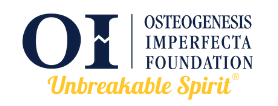Treatment for osteogenesis imperfecta (OI) is directed at managing the symptoms. A multidisciplinary approach to treatment is recommended for children and adults. The goal of all treatment is to minimize fractures, enhance independent function, reduce pain and promote general health. Current treatment approaches for the musculoskeletal aspects of OI include: physical therapy, fracture care, orthopedic surgery, medications to strengthen bones, and mobility equipment. Despite the obstacles they face, many people with OI are able to enjoy productive and fulfilling lives well into their adult years. A summary of treatment considerations based on OI Type (degree of severity) is included in the supporting documents.
Medications
- IV bisphosphonates (pamidronate (Aredia®) and zoledronate (Reclast®/Zometa®) to increase bone mass; may be started in neonatal period if infant can breathe on own.
- Supplement with vitamin D and calcium as needed.
- Both land and aquatic based programs.
- To improve function, address joint laxity, and improve cardiopulmonary status.
- To aid development of fine motor skills.
- To identify appropriate mobility aids.
Surgery
- To correct bowing of long bones; may involve osteotomies.
- To insert rods (intramedullary rodding surgery) to support long bones.
- To stabilize the spine.
Medications
- IV and oral bisphosphonates such as alendronate (Fosamax®), teriparatide (Forteo®) or other osteoporosis drugs to maintain bone mass.
- Supplement with vitamin D and calcium as needed
Physical and Occupational Therapy
- To maintain mobility.
- To adjust to physical changes due to injury and/or aging.
Surgery
- Joint replacement,
- Fracture Repair,
- Rod repair.
In addition to monitoring for general health and when a patient is receiving drug therapy, regularly evaluate:
- Lax joints.
- Muscle strength.
- Pain level changes; assess for a non-OI problem.
- Spine curve progression.
The effects of immobility are cumulative. Long periods of immobility further weaken bones and lead to muscle loss, weakness, and more fractures. Orthopedists who are familiar with OI recommend:
- Cast or splint with lightweight materials for shortest term possible.
- Limit use of the spica cast.
- Avoid the use of plates or pins for surgical fracture repair.
- Plan for rehabilitation services after fracture or surgery for people with all types of OI including Type I.
- Acute Care for fractures
- Immobilize for comfort;
- Fracture may not be visible in first set of x-rays particularly in child with severe OI;
- Address pain control
- Address muscle spasms
Goals for physical and occupational therapy include expanding and maintain function, promoting independence and moving into community based recreational physical activity programs. A typical program includes muscle strengthening and aerobic conditioning that focuses on the individual’s needs. Physical therapy often begins in infancy to counteract delays in motor skill development. It may be needed across the life span in response to injury, surgery or aging. Older children and teens benefit from continued physical activity such as adapted physical education and appropriate recreational activities. Swimming and water therapy are particularly well-suited to people with OI of all ages as it allows independent movement with little fracture risk. Walking is also excellent exercise for those who are able with or without mobility aids.
Surgery may be needed to repair a broken bone, correct bone deformities such as bowing, or stabilize the spine. Many children with OI undergo rodding surgery to insert metal rods into the long bones. For a discussion of IM Rodding, see the document Rodding Surgery. Issues related to orthopedic surgery for children and adults include positioning, thermal instability, anesthesia, and potential for excessive bleeding.
Spine curves and fractures are seen in all types of OI including the milder forms. Onset of scoliosis and other curves is often earlier than in most children. Curves may continue to change during the adult years. Vertebral fractures are also seen across the life span. Recommendations include:
- Monitor for scoliosis, kyphosis, and vertebral compression fractures.
- Evaluate for curve starting at age 2-3 years in Type III OI or age 6-8 years in mild OI.
- X-rays should be taken every 1-2 years, as observation alone may not be effective.
- For people who cannot stand independently, a standard scoliosis exam should consist of a seated AP and lateral x-ray with a level pelvis, except in cases of pelvic obliquity.
- If the person is able to stand independently, a standing x-ray with a level pelvis should be taken.
- Surgery is generally recommended following progression to 60 degrees.
- Factors to consider include age, balanced curve, leg length discrepancy, trunk imbalance, lung function and bone quality.
- Use of an intermittent soft brace can be effective in mild Type I OI and may work for mild Type IV OI. It is not recommended for other Types of OI due to stresses placed on sternum.
- Research into the role of exercise to improve or prevent scoliosis is ongoing.
Medications
At this time, there are no drug therapies specifically developed to treat OI in either children or adults. The drug therapies currently in use are based on medications developed to treat age-related osteoporosis or cancer-related bone loss in adults in the general population. Bone strengthening in an effort to reduce the frequency and seriousness of fractures is a key treatment issue for children and adults who have OI.
Bisphosphonates: Bisphosphonate drugs which are currently approved by the US Food and Drug Administration to prevent and treat osteoporosis and bone complications of cancer have become a standard treatment to increase bone density in children with moderated and severe OI. There are many different types of bisphosphonates. The two that are most often prescribed for people with OI are pamidronate (Aredia®) and zolendronic acid (Reclast®). Pamidronate has been studied the longest. Bisphosphonate treatment has been shown to reduce pain, and increase bone mineral density in children. The effects of such treatment on fracture frequency and bone deformity are less clear, but there are studies that have shown reduction in fracture rates in treated children. Side effects include a drop in blood levels of calcium especially at the start of the treatment and delayed bone healing after osteotomies. The longer-term side effects of pamidronate treatment are not well known. Several different protocols are currently in use. When to start treatment, most effective dose, and how long to treat are issues that continue to be studied. In children, once bisphosphonate treatment is initiated, it is important to maintain it (often at a reduced maintenance dose) until growth plates are fused in order to protect the new bone formed during the growing process. Bisphosphonates do not build new bone, or improve the quality of existing bone. They do not address any of the non-skeletal features of OI.
Zoledronic acid is a newer bisphosphonate that is given intravenously like pamidronate but only requires one 30-60 minute infusion every 6 months. It is as effective as pamidronate when the treatment is started; however the best dose for long-term treatment is not yet known. Alendronate (Fosamax®) is a bisphosphonate given orally. It has been shown to increase bone density but does not appear to have a significant effect on fracture rates or pain in children with OI. There is no evidence at this time of osteonecrosis of the jaw in children who have OI who are treated with the appropriate dose of a bisphosphonate. This problem has not been studied in adults with OI. See the supporting document Bisphosphonate Protocols for information on administering these drugs.
Use of Bone Building Drugs for Adults with OI: Adults who have OI frequently are treated with bisphosphonates and other drugs developed to treat age-related osteoporosis. Adults may receive oral or intravenous bisphosphonates. Unlike the experience with children, treatment with bisphosphonates has not been shown to significantly decrease fractures in the OI adult. In addition in studies conducted on adults with osteoporosis, it has been noted that some individuals experience musculoskeletal pain due to bisphosphonate treatment. This is now mentioned as a warning on the product insert for most types of bisphosphonates. Bone building drugs are typically not prescribed to young adults.
Teriparatide (Forteo®) is a medication that builds bone rather than preserving existing amount of bone like bisphosphonates. Teriparatide has been shown to increase bone mineral density and increase bone strength, but the effects on fracture are not clear. It appears that this form of treatment may be more beneficial to those with milder forms for OI. It is given as a daily injection. It has been approved by the US FDA as a treatment for osteoporosis in adults but it is not approved for use in children who are still growing.
Growth Hormone Therapy has been studied as a treatment for children with OI. Although people who have OI are sometimes short in stature, this does not appear to be due to a lack of growth hormone. Studies indicate the some children with OI (moderate OI Type IV) respond to a daily injection with an initial increase in growth. Responders show changes in bone architecture and small increased in BMD; bone strength and growth are also positively affected. There is no data at this time regarding any effect on fracture rate
Mobility Aids
Correct sizing of aids – walkers, canes, crutches and wheelchairs—is important to mobility and to reducing use-related injuries. It is not unusual for children and adults to use different mobility aids depending on whether they are at home, or out in the community.
Other Treatment
Information Additional information about treatments for hearing loss, cardiac, vision, respiratory and other problems associated with OI can be found in the Non-Skeletal Issues section of the this website. The sections on Pediatric and Adult Care cover treatment and management topics that are particular to either the child or the adult with OI.
References








